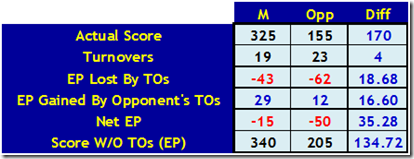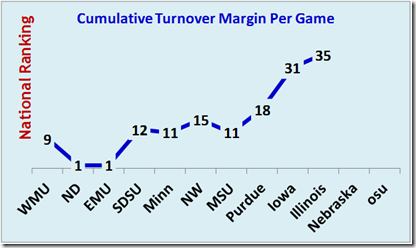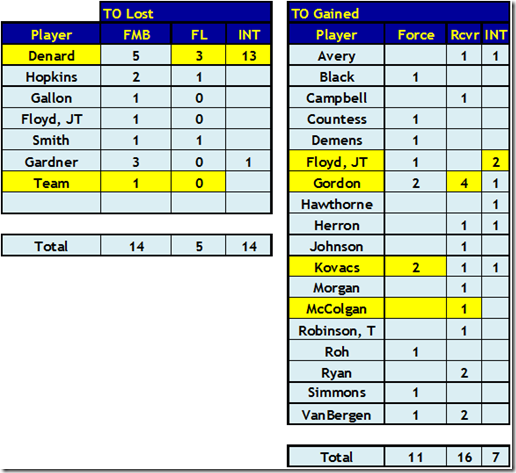Turnover Analysis Updated Thru Illinois
 Year To Date Summary: For the first ten games, Michigan's +4 TOM has resulted in a whopping advantage of 35 expected points – or almost 9 EP per turnover! With an average value per TO of just 3.68 EP (for all the TOs in M games this year), this would seem to be mathematically impossible. It is explained by the following:
Year To Date Summary: For the first ten games, Michigan's +4 TOM has resulted in a whopping advantage of 35 expected points – or almost 9 EP per turnover! With an average value per TO of just 3.68 EP (for all the TOs in M games this year), this would seem to be mathematically impossible. It is explained by the following:
(1) M has returned 3 TOs for touchdowns and the opponents have returned only 1 TO for a touchdown resulting in an additional 11.8 EP (versus simply gaining the TO).
(2) M has lost 5 fumbles but gained 16 and has lost 14 interceptions but gained just 7. On average fumbles are less costly than interceptions because interceptions occur further downfield and result in a lower field position disadvantage. The average EP for a fumble TO was 3.8 and the average value for an interception TO was 3.25 EP. This added 5.9 EP.
(3) M has the advantage over the opponent in all the following categories; TOs inside opponent 30 yard line, TOs inside your own 30 yard line, TOs on 3rd or 4th down (loss of possession would have resulted due to punt/over on downs regardless of TO). This added 2.6 EP.
Meaningless Turnover and Team Turnover: Michigan lost it's first meaningless turnover of the year when DRob threw the interception from the M44 with 0:02 seconds left in the first half. I have no clue why that play was even called. It just makes the interception stats for DRob look even worse. (Michigan had gained a meaningless turnover on the last play of the ND game.)
We also had our first "team" turnover – the bad snap to DRob at 11:59 of the third quarter. Illinois also had a bad snap during this game that was classified as a "team" turnover. I guess that means all bad snaps are not charged against either the QB or the center.
Synopsis for Turnovers: For the first time this year, the official turnover margin was zero. In reality, M had a +1 TOM because of the meaningless TO at the end of the half. For the year, Michigan has lost 19 TOs (ranked #78) but has gained 23 TOs (ranked #14) for a turnover margin of +4 or 0.40 per game (ranked #35). Michigan is ranked #9 in fumbles lost but is #111 in interceptions thrown. The 16 fumbles recovered is ranked #2 and is the reason the turnover margin is excellent instead of horrible.
McColgan recovered the Illini fumbled punt and there are now 18 different defensive players that have either forced a fumble, recovered a fumble, or intercepted a pass. Kovacs forced a fumble (his second), Gordon recovered a fumble (his fourth), and Floyd intercepted a pass (his second). DRob lost 2 fumbles and had the meaningless interception (his 13th).
M QBs had 16 turnovers thru ten games last year and have 17 turnovers thru ten games this year. After ten games, M had a –7 TOM last year and has a +4 TOM this year. This +11 differential in TOM has resulted in just one additional win over the ten games.
 Synopsis for Expected Point (EP) Analysis: Michigan has a net of 1 game won due to TOs.
Synopsis for Expected Point (EP) Analysis: Michigan has a net of 1 game won due to TOs. 
(See the Section on Gory Details below for how the adjustment for Expected Points (EP) is calculated.)
National Rankings: Remember the chart and table below includes the WMU game and will NOT be the same as the (incorrect) NCAA Rankings.
The Gory Details
Details for Turnovers: Here is overall summary for all games by player (data in yellow was affected by this week's game).
Expected Point (EP) Analysis: Basically, the probability of scoring depends on the line of scrimmage for the offense. Therefore, the impact of a TO also depends on the yard line where the TO is lost and the yard line where the TO is gained. Each turnover may result in an immediate lost opportunity for the team committing the TO and a potential gain in field position by the opponent. Both of these components can vary dramatically based upon the down when the TO occurred, the yards the TO is returned, and whether the TO was a fumble or an interception.
Here are the details for the game.
The analysis is a bit tricky because: (A) the TO may directly result in lost EP for the offense but (B) only modifies the EP for the team gaining the TO because the team gaining the TO would have gotten another possession even without the TO (due to a punt, KO after a TD, KO after a field goal, etc.). The Net EP Gain must take into account the potential EP gain without the TO. The EP gain without the turnover is based on where the field position would have been for the next possession if the TO had not occurred.
![image_thumb17_thumb_thumb_thumb_thum[2] image_thumb17_thumb_thumb_thumb_thum[2]](https://mgoblog.com/sites/mgoblog.com/files/image_thumb17_thumb_thumb_thumb_thum%5B2%5D_thumb.png) The expected point calculations are based on data from Brian Fremeau at BCFToys (he also posts at Football Outsiders). Fremeau's data reflects all offensive possessions played in 2007-2010 FBS vs. FBS games. I "smoothed" the actual data.
The expected point calculations are based on data from Brian Fremeau at BCFToys (he also posts at Football Outsiders). Fremeau's data reflects all offensive possessions played in 2007-2010 FBS vs. FBS games. I "smoothed" the actual data.
Here is a summary of the smoothed expected points.
November 15th, 2011 at 4:45 PM ^
Not particularly fond of tumbling down the national rankings in T/O margin. Happened last year too.
November 16th, 2011 at 8:14 AM ^
It's good to see some of these turnovers in context. The turnover numbers alone don't always provide useful information.






Comments